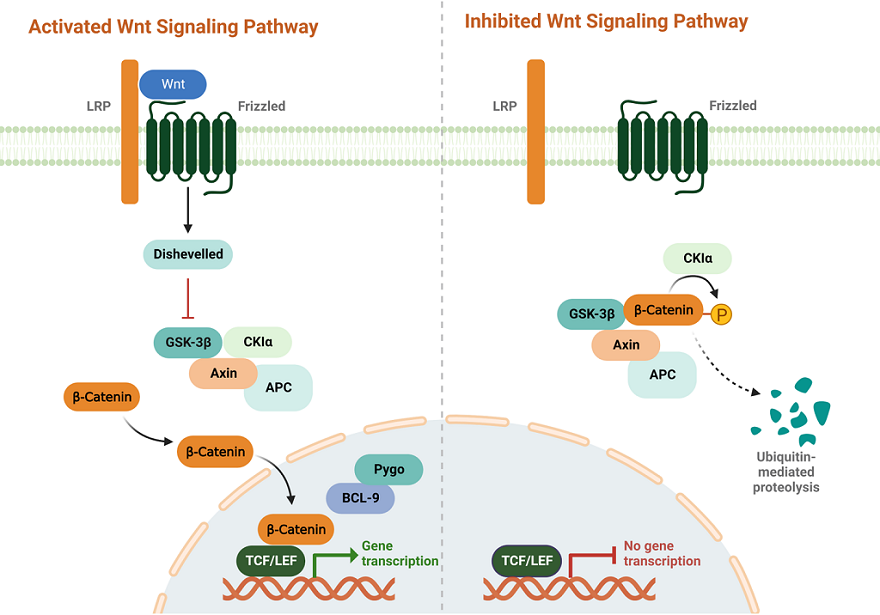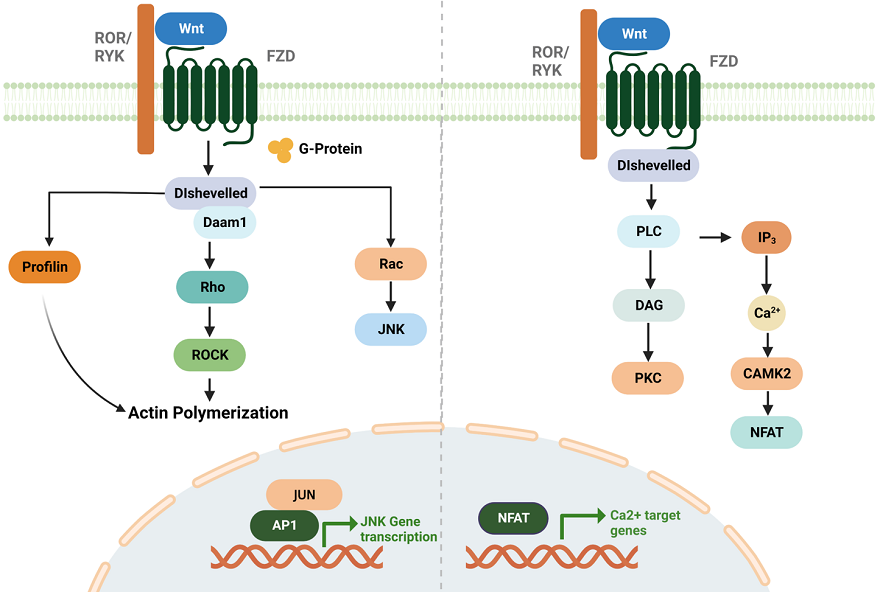Wnt Pathway
The Wnt pathway is a conserved signaling pathway in metazoan animals. The name Wnt is the resultant of a fusion of the name of the Drosophila segment polarity gene?"wingless"?and the name of the vertebrate homolog,? integrated or int-1 [4]. Wnt proteins constitute a large family of glycoproteins that are secreted and serve crucial roles in various biological processes such as embryonic development, cell differentiation, cell motility, cell proliferation, and maintenance of adult tissue equilibrium. The Wnt signaling pathway encompasses multiple mechanisms, including the ?-Catenin-dependent TCF/LEF transcription pathway, or the canonical pathway, as well as two well-characterized ?-Catenin-independent pathways known as the planar cell polarity (PCP) pathway and the Wnt/Ca2+ pathway, or the non-canonical pathway.
Wnt Signaling Pathway Antibody Panel
Canonical Wnt Pathway
In the ?-Catenin-dependent signaling pathway, Wnt proteins interact with Frizzled and LRP-5/6 receptors, initiating a cascade of events. This interaction activates dishevelled, which then recruits the Axin protein complex (consisting of Axin, APC, CK1, and GSK-3 ?) to the receptor. Within the Axin complex, two kinases, Glycogen Synthase Kinase-3 ? (GSK-3 ?) and Casein Kinase 1 (CK1), phosphorylate LRP-5/6. Subsequently, the entire protein complex is internalized into endosomes, leading to the formation of multivesicular bodies. These bodies sequester GSK-3 ?, hindering its ability to phosphorylate newly synthesized ?-Catenin. As a result, unphosphorylated ?-Catenin accumulates and translocates into the nucleus, where it associates with TCF/LEF family transcription factors and co-activators like Bcl-9 and Pygopus (Pygo). This association induces the expression of Wnt target genes. In the absence of Wnt, cytoplasmic ?-Catenin undergoes phosphorylation by CK1 and GSK-3 ? in a complex known as the ?-Catenin destruction complex (Axin, APC, CK1, GSK-3 ?). These phosphorylation events create a docking site for ?-TrCP, an E3 ubiquitin ligase that promotes the ubiquitination and subsequent degradation of ?-Catenin via the proteasome.

Non-Canonical Wnt Pathway
Besides the ?-Catenin-dependent pathway, there are two well-characterized ?-Catenin-independent Wnt signaling pathways: the PCP pathway and the Wnt/Ca2+ pathway. Both pathways act as inhibitors of Wnt-?-Catenin-dependent signaling. In the PCP pathway, Wnt binding to Frizzled receptors, along with co-receptors such as ROR1/2, Ryk, or PTK7, triggers receptor internalization and activates downstream components like Rho and Rac GTPases, Rho-Kinase (ROCK), and c-Jun N-terminal kinase (JNK). Together, these components regulate cell motility and tissue polarity.
On the other hand, the Wnt-Ca2+ pathway is initiated by Frizzled receptors engaging in classical G protein-coupled signaling. Frizzled-G protein signaling activates Phospholipase C-? (PLC-?), which cleaves phosphatidylinositol 4,5-bisphosphate (PIP2) into 1,2-diacylglycerol (DAG) and inositol 1,4,5-triphosphate (IP3). DAG and IP3 production leads to the activation of Protein Kinase C (PKC), Calcium/Calmodulin-dependent Protein Kinase type II (CaMKII)-TGF-?-activated kinase 1 (TAK1)-Nemo-like kinase (NLK) pathway, and Calcineurin phosphatase. These activated components collectively regulate cell fate and cell migration by modulating specific genes.

Wnt Target Gene Antibody Panel
The Wnt/?-catenin pathway plays critical roles in embryonic development and adult tissue homeostasis. The dysregulation of Wnt/?-catenin signaling often leads to many serious diseases, including cancer and non-cancer diseases. The multifaceted significance of studying the Wnt pathway becomes apparent when considering its impact on development, stem cell biology, cancer research, tissue homeostasis, neurobiology, drug discovery, and evolutionary biology. Through in-depth investigations, researchers can unravel the intricate mechanisms of the Wnt pathway, leading to improved diagnostics, targeted therapies, regenerative medicine approaches, and a deeper understanding of fundamental biological processes.
Tools to Study Wnt Pathway Markers
Antibodies Proteins Plasmids Lentivirus AAV Custom SolutionsReferences
- Liu, Jiaqi, et al. "Wnt/?-catenin signalling: function, biological mechanisms, and therapeutic opportunities."?Signal transduction and targeted therapy?7.1 (2022): 3.
- Patel, Sonal, et al. "Wnt signaling and its significance within the tumor microenvironment: novel therapeutic insights."?Frontiers in immunology?10 (2019): 2872.
- Pai, Sachin Gopalkrishna, et al. "Wnt/beta-catenin pathway: modulating anticancer immune response."?Journal of hematology & oncology?10 (2017): 1-12.
- Zhang, Ya, and Xin Wang. "Targeting the Wnt/?-catenin signaling pathway in cancer."?Journal of hematology & oncology?13 (2020): 1-16.






























































































































































































































































 Germany
Germany
 Japan
Japan
 United Kingdom
United Kingdom
 China
China